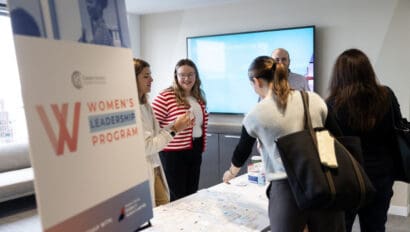Research & Insights
Lead with Your Best Self: 3 Practices Every Leader Needs Right Now

In today’s environment of constant transition—organizational restructuring, shifting expectations, and even the whirlwind of everyday life—leaders are under pressure not just to perform, but to lead with clarity, resilience, and humanity.
During a recent webinar hosted by the Simmons University Institute for Inclusive Leadership, Susan MacKenty Brady offered a compelling reminder: leading with your best self is not a luxury. It’s a leadership imperative.
Here are three practices she shared that every leader should anchor in, especially when navigating the uncertainty of rapid change:
1. Ground Yourself in Your Best Self—Then Lead from There
Your best self isn’t just a nice-to-have version of you—it’s the most powerful and effective version. It’s when your unique strengths, values, and energy are in alignment, and when you show up with clarity and confidence.
Susan defines your Best Self as the intersection of:
- Your strengths and talents
- The value you bring to others
- What brings you energy and vitality
When you lead from this place, you create a ripple effect—instilling confidence in others and generating a sense of purpose that transcends to your team. Especially during turbulent times, returning to your best self is not just grounding—it’s catalytic.
Leadership takeaway: Start your day with a conscious check-in: What strengths do I bring today? Where can I add value? What will fuel me? This trifecta is your compass.
2. Practice Relentless Appreciation—Even When It’s Hard
In uncertain times, it’s easy to focus on what’s missing or what’s wrong. But gratitude—genuine, frequent, and specific—is a force multiplier.
Susan shared powerful research: teams that consistently express appreciation outperform others, with higher productivity and retention. More importantly, the act of appreciation reinforces a culture where people feel seen, valued, and motivated.
Leadership takeaway: Make appreciation a daily habit. Say thank you often. Call out small wins. Recognize others—up, down, and across. Leaders need encouragement just as much as their teams.
3. Lead with Curious, Honest Communication
One of the greatest sources of uncertainty is silence. When people feel left out of the loop—or assume the worst in an information vacuum—trust erodes.
That’s why Susan urges leaders to practice honest, curious intent. Even when you don’t have all the answers, you can lead with transparency, empathy, and a desire to understand.
This means asking questions like:
- “Can you help me understand?”
- “What might I be missing?”
- “How did that land with you?”
But here’s the key: these questions only work when you’re grounded in your best self. When asked from a place of anxiety or blame, they don’t build connection—they create distance. Begin with respect—for yourself and for others—and let that guide how you communicate.
Leadership takeaway: In the absence of certainty, offer clarity. In the absence of answers, offer presence.
In closing, Susan reminded us of something deeply human: you are enough. Even amidst change. Even when things are messy. Even when you don’t feel fully in control. Leading from your best self isn’t about perfection. It’s about returning—again and again—to the version of you that leads with respect, gratitude, and purpose.
So the next time you feel off-center, ask yourself: What would it look like to lead from my best self right now?
The answer might just change your day—and someone else’s too.
Want more tools to lead with intention? Join the “May You Be Your Best Self” movement—an invitation to explore leadership that’s grounded, human, and built for impact. Check out these tools to help you step into thriving.




